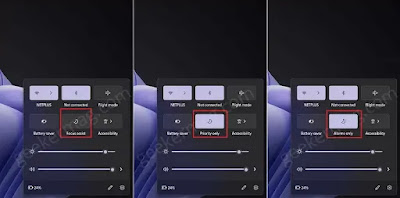Setting up and using Focus Assist for concentration
Setting Up and Using Focus Assist for Concentration in Windows 11
Focus
Assist is a feature in Windows 11 that helps you concentrate by minimizing
distractions. It allows you to customize notifications and control what alerts
you see while you're working or engaged in other activities. This guide will
walk you through the setup and effective use of Focus Assist.
Step 1: Accessing Focus Assist Settings
- Open Settings:
- Click on the Start Menu
(Windows icon) on the taskbar.
- Select the Settings
gear icon or press Windows Key + I to open Settings directly.
- Navigate to System Settings:
- In the Settings window,
click on System from the left sidebar.
- Select Focus Assist:
- Scroll down and click on Focus
assist in the System settings.
Step 2: Configuring Focus Assist
1. Choose Your Focus Assist Level
Focus
Assist offers three modes to choose from:
- Off: All notifications are
shown.
- Priority only: Only notifications from
apps and contacts you choose will be shown.
- Alarms only: Only alarms will be shown,
and all other notifications will be hidden.
- To select a mode, click on
the appropriate option under Focus assist.
2. Customize Priority List (For Priority Only Mode)
- Edit Priority List:
- Click on Customize your
priority list to select which notifications are allowed during Focus
Assist.
- Add Apps or Contacts:
- Click Add apps to
choose specific applications that can send notifications when Focus
Assist is on.
- Under People, you
can add contacts whose notifications you want to receive.
- Remove or Modify Entries:
- You can also remove apps or
contacts from the list or adjust their priority settings.
3. Automatic Rules
You can
set automatic rules to enable Focus Assist during specific times or activities:
- During these times: Schedule Focus Assist to
turn on automatically during specified hours. Toggle the switch to enable
this option and set your preferred start and end times.
- When I'm playing a game: Focus Assist can turn on
automatically when you launch a full-screen game.
- When duplicating my display: This option can be enabled
to automatically turn on Focus Assist when you connect to a projector or
external monitor.
- When I'm using an app in
full-screen mode: Enable this option to automatically activate
Focus Assist when you enter full-screen mode in any application.
4. Notifications
- Decide whether you want to
see notifications in the Action Center while Focus Assist is
active. You can toggle the Show a summary of what I missed while Focus
Assist was on option if you want to see missed notifications after
Focus Assist is turned off.
Step 3: Using Focus Assist
1. Turning On Focus Assist Manually
- Using Quick Settings:
- Click on the Quick
Settings button in the taskbar (the icon that looks like a speech
bubble or Wi-Fi signal).
- Find and click on the Focus
assist tile to toggle it on or off. You can also select the desired
mode directly from this menu.
- Using Keyboard Shortcut:
- Press Windows Key + A
to open the Quick Settings panel and click the Focus Assist tile.
2. Check Focus Assist Status
- When Focus Assist is active,
you will see an icon in the taskbar. Hover over it to view details about
the current mode.
3. Disabling Focus Assist
- To disable Focus Assist,
simply toggle it off in the Quick Settings panel or in the Focus assist
settings menu.
Conclusion
Focus
Assist in Windows 11 is a powerful tool for enhancing your concentration by
minimizing distractions. By configuring its settings according to your
preferences, you can create an environment conducive to productivity. Whether
you are working, studying, or engaged in leisure activities, utilizing Focus
Assist can significantly improve your focus and overall experience on Windows
11. Regularly adjusting these settings will ensure that they align with your
changing needs and preferences.



